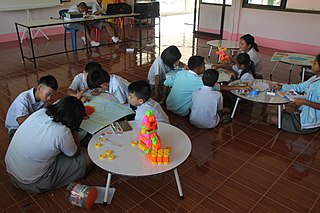Challenge-based learning (CBL) is a framework for learning while solving real-world Challenges. The framework is collaborative and hands-on, asking all participants (students, teachers, families, and community members) to identify Big Ideas, ask good questions, discover and solve Challenges, gain in-depth subject area knowledge, develop 21st-century skills, and share their thoughts with the world. [1]
Challenge-based learning builds on the foundation of experiential learning, leans heavily on the wisdom of a long history of progressive education, shares many of the goals of service learning, and the activism of critical pedagogy. [2] The framework is informed by innovative ideas from education, media, technology, entertainment, recreation, the workplace, and society.
The Challenge Based Learning framework emerged from the "Apple Classrooms of Tomorrow—Today" (ACOT2) project initiated in 2008 by Apple, Inc. to identify the essential design principles of a 21st-century learning environment (Apple Inc., 2008). [3] Starting with the ACOT2 design principles, a team from Apple, Inc. worked with exemplary educators to develop, test and implement challenge-based learning.
Using Challenges to frame learning experiences originated from an exploration of reality television, conversations with individuals whose lives center on Challenges, and reflection on personal learning experiences inside and outside of the classroom. When faced with a Challenge, successful groups and individuals leverage experience, harness internal and external resources, develop a plan and push forward to find the best solution. Along the way, there is experimentation, failure, success and ultimately consequences for actions. By adding Challenges to learning environments the result is urgency, passion, and ownership – ingredients often missing in schools.
The initial framework was documented in a white paper written in 2008 and published by Apple, Inc (Nichols and Cator, 2009). Since that time teachers and schools around the world have adopted the framework to improve teaching and learning while allowing students to make an immediate difference in their community. [4]
In 2009 New Media Consortium published an in-depth study of challenge-based learning in classroom practice. The study, which involved 6 schools in the United States, 29 teachers, and 330 students in 17 disciplines, found the approach produced dramatically effective results, especially for the 9th-grade students considered to be most at risk of dropping out (Johnson, et al., 2009). [5]
In 2011 an additional study was conducted to test if the framework applied to a larger K-20 audience and to look deeper into the acquisition of 21st century skills. This study includes 19 schools, 90 teachers and 1500 students from three countries. Once again the research demonstrated that CBL is an effective way to engage students, meet curriculum standards, and gain 21st-century skills. The research also concluded that CBL could be used with students of all ages (Johnson and Adams, 2011).
In 2016 Apple Inc. engaged Digital Promise, and members of the team that created CBL to update the content, manage the website and develop a book (Nichols, et al., 2016). [6]
The updated framework in organized into three phases:
Throughout the process, all participants are expected to document the experience, reflect on practice and share the experience with the world.
The CBL framework has been extended into new areas including strategic planning, workplace training (O'Mahony, et al., 2012), [7] and mobile software instruction and development (Santos, et al., 2015).
Challenge-based learning is a flexible framework, with each implementation, new ideas surface, the framework is reviewed, and the model evolves.
Challenge-based learning provides:
A teaching method is a set of principles and methods used by teachers to enable student learning. These strategies are determined partly on subject matter to be taught and partly by the nature of the learner. For a particular teaching method to be appropriate and efficient it has take into account the learner, the nature of the subject matter, and the type of learning it is supposed to bring about.
Situated learning is a theory that explains an individual's acquisition of professional skills and includes research on apprenticeship into how legitimate peripheral participation leads to membership in a community of practice. Situated learning "takes as its focus the relationship between learning and the social situation in which it occurs".

Student-centered learning, also known as learner-centered education, broadly encompasses methods of teaching that shift the focus of instruction from the teacher to the student. In original usage, student-centered learning aims to develop learner autonomy and independence by putting responsibility for the learning path in the hands of students by imparting to them skills, and the basis on how to learn a specific subject and schemata required to measure up to the specific performance requirement. Student-centered instruction focuses on skills and practices that enable lifelong learning and independent problem-solving. Student-centered learning theory and practice are based on the constructivist learning theory that emphasizes the learner's critical role in constructing meaning from new information and prior experience.

Experiential education is a philosophy of education that describes the process that occurs between a teacher and student that infuses direct experience with the learning environment and content. The term is not interchangeable with experiential learning; however experiential learning is a sub-field and operates under the methodologies of experiential education. The Association for Experiential Education regards experiential education as "a philosophy that informs many methodologies in which educators purposefully engage with learners in direct experience and focused reflection in order to increase knowledge, develop skills, clarify values, and develop people's capacity to contribute to their communities". Experiential education is the term for the philosophy and educational progressivism is the movement which it informed. The Journal of Experiential Education publishes peer-reviewed empirical and theoretical academic research within the field.

Experiential learning (ExL) is the process of learning through experience, and is more narrowly defined as "learning through reflection on doing". Hands-on learning can be a form of experiential learning, but does not necessarily involve students reflecting on their product. Experiential learning is distinct from rote or didactic learning, in which the learner plays a comparatively passive role. It is related to, but not synonymous with, other forms of active learning such as action learning, adventure learning, free-choice learning, cooperative learning, service-learning, and situated learning.

Andragogy refers to methods and principles used in adult education. The word comes from the Greek ἀνδρ- (andr-), meaning "adult male", and ἀγωγός (agogos), meaning "leader of". Therefore, andragogy literally means "leading men ", whereas "pedagogy" literally means "leading children".

Project-based learning (PBL) is a student-centered pedagogy that involves a dynamic classroom approach in which it is believed that students acquire a deeper knowledge through active exploration of real-world challenges and problems. Students learn about a subject by working for an extended period of time to investigate and respond to a complex question, challenge, or problem. It is a style of active learning and inquiry-based learning. PBL contrasts with paper-based, rote memorization, or teacher-led instruction that presents established facts or portrays a smooth path to knowledge by instead posing questions, problems, or scenarios.
Editing technology is the use of technology tools in general content areas in education in order to allow students to apply computer and technology skills to learning and problem-solving. Generally speaking, the curriculum drives the use of technology and not vice versa. Technology integration is defined as the use of technology to enhance and support the educational environment. Technology integration in the classroom can also support classroom instruction by creating opportunities for students to complete assignments on the computer rather than with normal pencil and paper. In a larger sense, technology integration can also refer to the use of an integration platform and application programming interface (API) in the management of a school, to integrate disparate SaaS applications, databases, and programs used by an educational institution so that their data can be shared in real-time across all systems on campus, thus supporting students' education by improving data quality and access for faculty and staff.
"Curriculum integration with the use of technology involves the infusion of technology as a tool to enhance the learning in a content area or multidisciplinary setting... Effective technology integration is achieved when students can select technology tools to help them obtain information on time, analyze and synthesize it, and present it professionally to an authentic audience. Technology should become an integral part of how the classroom functions—as accessible as all other classroom tools. The focus in each lesson or unit is the curriculum outcome, not the technology."
Universal Design for Learning (UDL) is an educational framework based on research in the learning sciences, including cognitive neuroscience, that guides the development of flexible learning environments and learning spaces that can accommodate individual learning differences.
Culturally relevant teaching or responsive teaching is a pedagogy grounded in teachers' practice of cultural competence, or skill at teaching in a cross-cultural or multicultural setting. Teachers using this method encourage each student to relate course content to their cultural context.
Personalized learning, individualized instruction, personal learning environment and direct instruction all refer to efforts to tailor education to meet the different needs of students.
Inquiry-based learning is a form of active learning that starts by posing questions, problems or scenarios. It contrasts with traditional education, which generally relies on the teacher presenting facts and their knowledge about the subject. Inquiry-based learning is often assisted by a facilitator rather than a lecturer. Inquirers will identify and research issues and questions to develop knowledge or solutions. Inquiry-based learning includes problem-based learning, and is generally used in small-scale investigations and projects, as well as research. The inquiry-based instruction is principally very closely related to the development and practice of thinking and problem-solving skills.
Dogme language teaching is considered to be both a methodology and a movement. Dogme is a communicative approach to language teaching that encourages teaching without published textbooks and focuses instead on conversational communication among learners and teacher. It has its roots in an article by the language education author, Scott Thornbury. The Dogme approach is also referred to as "Dogme ELT", which reflects its origins in the ELT sector. Although Dogme language teaching gained its name from an analogy with the Dogme 95 film movement in which the directors, actors, and actresses commit a "vow of chastity" to minimize their reliance on special effects that may create unauthentic feelings from the viewers, the connection is not considered close.

Computers in the classroom include any digital technology used to enhance, supplement, or replace a traditional educational curriculum with computer science education. As computers have become more accessible, inexpensive, and powerful, the demand for this technology has increased, leading to more frequent use of computer resources within classes, and a decrease in the student-to-computer ratio within schools.

Indigenous education specifically focuses on teaching Indigenous knowledge, models, methods, and content within formal or non-formal educational systems. The growing recognition and use of Indigenous education methods can be a response to the erosion and loss of Indigenous knowledge through the processes of colonialism, globalization, and modernity.
Feminist pedagogy is a pedagogical framework grounded in feminist theory. It embraces a set of epistemological theories, teaching strategies, approaches to content, classroom practices, and teacher-student relationships. Feminist pedagogy, along with other kinds of progressive and critical pedagogy, considers knowledge to be socially constructed.
In education, authentic learning is an instructional approach that allows students to explore, discuss, and meaningfully construct concepts and relationships in contexts that involve real-world problems and projects that are relevant to the learner. It refers to a "wide variety of educational and instructional techniques focused on connecting what students are taught in school to real-world issues, problems, and applications. The basic idea is that students are more likely to be interested in what they are learning, more motivated to learn new concepts and skills, and better prepared to succeed in college, careers, and adulthood if what they are learning mirrors real-life contexts, equips them with practical and useful skills, and addresses topics that are relevant and applicable to their lives outside of school."
Global citizenship education (GCED) is a form of civic learning that involves students' active participation in projects that address global issues of a social, political, economic, or environmental nature. The two main elements of GCE are 'global consciousness'; the moral or ethical aspect of global issues, and 'global competencies', or skills meant to enable learners to participate in changing and developing the world. The promotion of GCE was a response by governments and NGOs to the emergence of supranational institution, regional economic blocs, and the development of information and communications technologies. These have all resulted in the emergence of a more globally oriented and collaborative approach to education. GCE addresses themes such as peace and human rights, intercultural understanding, citizenship education, respect for diversity and tolerance, and inclusiveness.
Design-based learning (DBL), also known as design-based instruction, is an inquiry-based form of learning, or pedagogy, that is based on integration of design thinking and the design process into the classroom at the K-12 and post-secondary levels. Design-based learning environments can be found across many disciplines, including those traditionally associated with design, as well as others not normally considered to be design-related. DBL, as well as project-based learning and problem-based learning, is used to teach 21st century skills such as communication and collaboration and foster deeper learning.

The term learning environment can refer to an educational approach, cultural context, or physical setting in which teaching and learning occur. The term is commonly used as a more definitive alternative to "classroom", but it typically refers to the context of educational philosophy or knowledge experienced by the student and may also encompass a variety of learning cultures—its presiding ethos and characteristics, how individuals interact, governing structures, and philosophy. In a societal sense, learning environment may refer to the culture of the population it serves and of their location. Learning environments are highly diverse in use, learning styles, organization, and educational institution. The culture and context of a place or organization includes such factors as a way of thinking, behaving, or working, also known as organizational culture. For a learning environment such as an educational institution, it also includes such factors as operational characteristics of the instructors, instructional group, or institution; the philosophy or knowledge experienced by the student and may also encompass a variety of learning cultures—its presiding ethos and characteristics, how individuals interact, governing structures, and philosophy in learning styles and pedagogies used; and the societal culture of where the learning is occurring. Although physical environments do not determine educational activities, there is evidence of a relationship between school settings and the activities that take place there.
{{cite journal}}: Cite journal requires |journal= (help){{cite journal}}: CS1 maint: DOI inactive as of January 2024 (link)